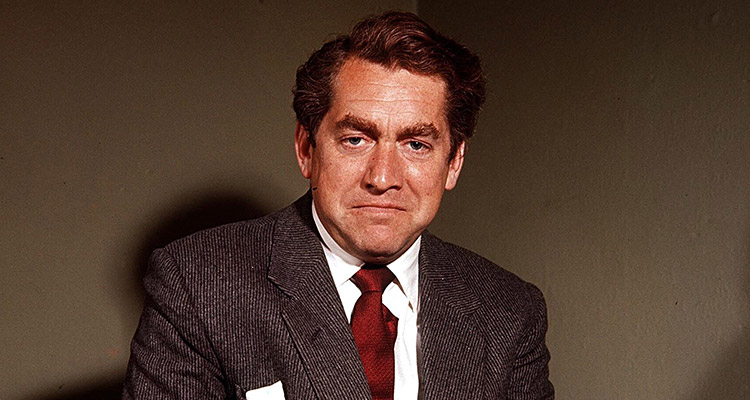Tony Hancock 12th May, 1924 – 24th June, 1968
Continuing our look at some of the biggest and most important names from comedy over the last 70 years. Today it’s the lad himself: Tony Hancock.
Regarded by many as perhaps the greatest post war comedian of his generation, here we take a look at the life and career of Tony Hancock.
Quick Bio
Born Anthony John Hancock on 12 May 1924, in Southam Road, Hall Green, Birmingham, but from the age of three was brought up in Bournemouth, where his Father, John Hancock, who ran the Railway Hotel in Holdenhurst Road, worked as a comedian and entertainer.
Following the death of his Father in 1934, Hancock and his brothers lived with their mother and stepfather at a small hotel then called The Durlston Court (now renamed The Quality Hotel). He attended Durlston Court Preparatory School, a boarding school at Durlston in Swanage and Bradfield College in Reading, Berkshire, but left school at the age of fifteen.
In 1942, during World War 2, Hancock joined the RAF, following a failed audition for the Entertainments National Service Assocaiation (ENSA). He landed a part on the Ralph Reader Gang Show. At the end of the war Hancock returned to the stage, eventually working as the resident comedian at the Windmill Theatre. He also worked on radio shows such as Workers Playtime and Variety Bandbox.
Personal Life
Hancock married his first wife, model Cicely Romanis, in June 1950. Things became more complicated as Freddie Ross (who worked as his publicist from 1954) became more involved in his life, eventually becoming his mistress.
He divorced his first wife five years after they were married in 1965 and married Freddie in December of that year. This second marriage was short-lived (it would last less than three years) the final dissolution came just days before his death.
During these years Hancock became involved with Joan Le Mesurier (née Malin), the new wife of actor of John Le Mesurier.
Despite his comic ability, Hancock battled alcoholism through out his career, it was a cocktail of drink and drugs that played their part in his eventual suicide.
Career
In 1951, Hancock joined the cast of Educating Archie, where he played the tutor and foil to the star (a ventriloquist’s dummy). During the same year he made regular appearances on BBC Television’s popular light entertainment show Kaleidoscope.
It was whilst appearing in the BBC Radio series ‘Happy Go Lucky’ he came across two budding scriptwriters who had been brought in to rescue the show. Those two writers were Ray Galton and Alan Simpson. That chance meeting changed Hancock’s career and indeed that of Galton and Simpson. In 1952 Hancock played the tutor of Archie Andrews in the popular radio series Educating Archie. It was 1952 when Hancock again became involved with Galton and Simpson. Calling All Forces was the big show of the day, written by Bob Monkhouse and Dennis Goodwin. Hancock was co-host with Charlie Chester, when Galton and Simpson were brought in to complete the series after Monkhouse and Goodwin had gone on holiday. This show became Star Bill and Hancock found himself as host.
It was 1954 when he was given his own BBC radio show in his own name Hancock’s Half Hour.
With scripts by Ray Galton and Alan Simpson Hancock’s Half Hour ran for five years as a radio show and from 1956 – 1959 concurrently with the equally successful television show of the same name. During 1956 & 1957 Hancock also made two series for ITV, entitled The Tony Hancock Show, it ran either side of his BBC shows. In 1961 concerned his work with Sid James was turning them into a double act he made one last series for the BBC simply entitled Hancock. This took on a slightly different format most notably that his previous work for the BBC had been half hour episodes, Hancock was twenty five minutes.
In 1960 Hancock starred in a film written by Ray Galton and Alan Simpson entitled The Rebel where he plays the role of an office worker-turned artist who finds himself successful after a move to Paris, but only as the result of mistaken identity.
The break with Galton and Simpson came in October of 1961 after they had developed three scripts (without payment) for Hancock’s second big screen outing, two of them were abandoned incomplete. Worried the scripts were not right for him Hancock chose instead to develop his own project and made the break with Galton and Simpson. The resulting project was The Punch and Judy Man in 1962 in which Hancock plays a struggling seaside entertainer who dreams of a better life. He was supported by Sylvia Sims as his nagging, social climber wife and John Le Mesurier as a sand sculptor. Hancock co-wrote the screenplay with Phillip Oakes.
A series for ATV in 1962 screened at the same time as Steptoe was not well received. A series of egg commercials appeared in 1965. There were regular television appearances until 1967. Contracted to make a 13 part series entitled Hancock Down Under for the Seven Network of Australia. He arrived in Australia in March of 1968, but only completed three episodes before his tragic suicide on 24 June 1968.
Clips
[AdSense-A]
[AdSense-A]
[AdSense-A]

